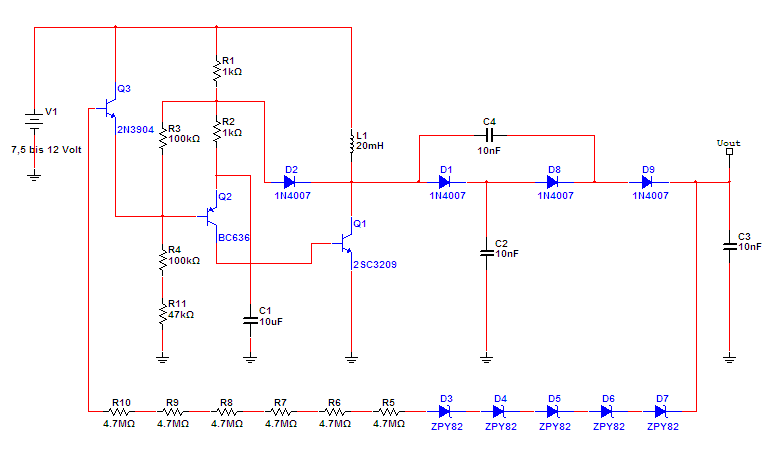I’m currently building a GM counter for a friend and was looking for nice, low
power circuits working on 9V cells.
I found this circuit which is derivative of Charles Wenzel’s designs:
http://www.mikrocontroller.net/attachment/103170/Geiger_Hochspannung.png
Components are fairly basic apart from the HV transistor and zeners. The other
transistors can be basically any small signal PNP/NPN transistor from the
junkbox. I used BC547 and BC557 and a MPSA44 HV transistor.
This circuit works as follows: The inductor, the HV transistor Q1 and the PNP transistor Q2 form an oscillator which lets current flow into the inductor, and at a certain point the current is shut off, generating a high voltage across the inductor. This pulse is then fed into the voltage multiplier which triples the voltage. The oscillator runs (and the voltage rises) as long as the voltage is below the combined breakdown voltage of the zener diodes. If the voltage is exceeded, the resulting current will turn on Q3, which brings the base of Q2 high, causing the oscillator to stop.
One thing to remember with constructing this circuit (and any HV circuit) is to keep the PCB clean, I had to rebuild the entire circuit because somewhere there was a HV leak which caused
the voltage to sag and continuous current use of 15 mA.
When running it consumes less than 250 uA of average current which is very
little. On a scope you can see how the circuit “fills up” the HV caps each time
the voltage gets below the breakdown voltage of the zener diodes.
I made a simple clicker circuit by adding a BC517 darlington which connects a
LED and a speaker in series with the 9V supply momentarily whenever there is a
pulse from the tube.
I made a video of the circuit in operation, shown is some uranium glass and
thorium mantles (acquired through K0FF 🙂 ).
This is one of the nicest circuits I have built, it results in a small footprint
setup with low current draw. No special transformers are required and most
components are fairly standard. When paired with a small sensitive tube you can
make a fairly small counter for general use which should run for weeks on end
(in clean environments, that is 🙂 ).

